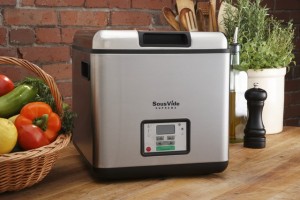For the humble home cook, the options for making food edible are mostly limited to the basics: sauteing, steaming, baking, broiling, and perhaps the occasional flambe. But these days, more and more people are getting fancy in the kitchen. And fancy foodies love a complicated cooking method.

Sous-vide, French for “under vacuum,” is a method of cooking meats and vegetables which seems to be gaining popularity with restaurateurs and home cooks alike, despite the fact that the machine required to do the job will run you about $500.
Food cooked in the sous-vide style is vacuum-sealed in a plastic bag then cooked at a low but steady temperature for up to 72 hours. Kind of like a crock pot, but with more pretentiousness and plastic.
The whole point of the sous-vide method is to cook foods evenly. Instead of the browned on the outside, pink on the inside result one might get from grilling a steak, sous-vide ensures the meat is exactly the right temperature all the way through.
In a recent episode of America’s Best Home Cook, a show where “regular Joes” compete to impress Chef Bobby Flay with their culinary skills, one of the teams thought using a sous-vide machine was sure to secure them a victory. Sadly, Bobby was not impressed. That’s because cooking anything sous-vide for less than a few hours results in runny egg whites, bloody meats, and generally inedible meals.
Because of the low temperature, undercooking is a risk, but there are more worrisome hazards associated with the sous-vide method, like the rare chance of a little thing called botulism. Not to mention the fact that this glorified pressure-cooker requires you to cook food in a plastic bag. Haven’t we been told hot plastic is a bad thing? Doesn’t it leech carcinogenic chemicals into our food? Well, hey, if the French say a plastic bag is a key to fine dining, who are we to argue?
According to popular DIY site Lifehacker, you can achieve sous-vide results without the expensive machine, but is it really worth the trouble?
If Flay isn’t won over by this overly complicated cooking method, chances are grandma won’t even notice the difference to her Easter ham.
